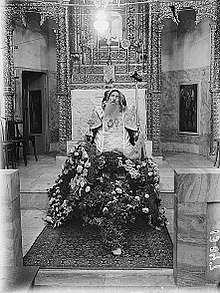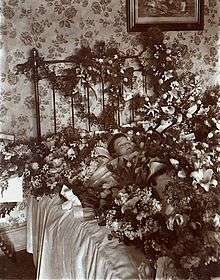Post-mortem photography
Post-mortem photography (also known as memorial portraiture or a mourning portrait) is the practice of photographing the recently deceased. These photographs of deceased loved ones were a normal part of American and European culture in the nineteenth and early twentieth centuries. Commissioned by grieving families, postmortem photographs not only helped in grieving, but often represented the only visual remembrance of the deceased and were among a family's most precious possessions.[1] There can be considerable dispute as to whether individual early photographs actually show a dead person or not, often sharpened by commercial considerations.
The form continued the tradition of earlier painted mourning portraits. Today post-mortem photography is most common in the contexts of police and pathology work.
History and popularity
The invention of the daguerreotype in 1839 made portraiture much more commonplace, as many of those who were unable to afford the commission of a painted portrait could afford to sit for a photography session. This cheaper and quicker method also provided the middle class with a means for memorializing dead loved ones.
Post-mortem photography was very common in the nineteenth century when "death occurred in the home and was quite an ordinary part of life."[2] As photography was a new medium, it is plausible that "many daguerreotype post-mortem portraits, especially those of infants and young children, were probably the only photographs ever made of the sitters. The long exposure time made deceased subjects easy to photograph.'"[2] (The problem of long exposure times also led to the phenomenon of hidden mother photography, where the mother was hidden in-frame to calm a young child and keep them still.[3]) According to Mary Warner Marien, "post-mortem photography flourished in photography's early decades, among clients who preferred to capture an image of a deceased loved one rather than have no photograph at all."[4]
These photographs served as keepsakes to remember the deceased. The later invention of the carte de visite, which allowed multiple prints to be made from a single negative, meant that copies of the image could be mailed to relatives. Approaching the 20th century, cameras became more accessible and more people began to be able to take photographs for themselves.
The practice eventually peaked in popularity around the end of the 19th century and died out as "snapshot" photography became more commonplace, although a few examples of formal memorial portraits were still being produced well into the 20th century.
Evolving style

The earliest post-mortem photographs are usually close-ups of the face or shots of the full body and rarely include the coffin. The subject is usually depicted so as to seem in a deep sleep, or else arranged to appear more lifelike. Many of these subjects were also clothed in their best apparel. After all, these photographs would serve as their last social presence.[5] Children were often shown in repose on a couch or in a crib, sometimes posed with a favorite toy or other plaything. It was not uncommon to photograph very young children with a family member, most frequently the mother. Flowers were also a common prop in post-mortem photography of all types.

While some images (especially tintypes and ambrotypes) have a rosy tint added to the cheeks of the corpse, it is untrue that metal stands and other devices were used to pose the dead as though they were living.[6] The use by photographers of a stand or arm rest (sometimes referred to as a Brady stand), which aided living persons to remain still long enough for the camera's lengthy exposure time, has given rise to this myth. While 19th-century people may have wished their loved ones to look their best in a memorial photograph, evidence of a metal stand should be understood as proof that the subject was a living person.[6]
Later photographic examples show the subject in a coffin. Some very late examples show the deceased in a coffin with a large group of funeral attendees; this type of photograph was especially popular in Europe and less common in the United States.[7]
Post-mortem photography is still practised and is common in America among women who experienced stillbirth, where the mother or parents are photographed holding the stillborn child, and commemorated on websites such as "Now I Lay Me Down To Sleep".[8] This style of mother holding child was also common in the Victorian era when death of infants was common.[9] Photographs, especially depicting persons who were considered to be very holy lying in their coffins, are still circulated among faithful Eastern Catholic, Eastern Orthodox and Oriental Orthodox Christians.[10]
A variation of the memorial portrait involves photographing the family with a shrine (usually including a living portrait) dedicated to the deceased.
In other cultures
Iceland
It is believed that the post-mortem photography died out in the Nordic countries around 1940. When examining Iceland's culture surrounding death, it is concluded that the nation held death as an important and significant companion.[11] Throughout much of the nineteenth century, the country's infant mortality rate was higher than the rest of European countries. Consequently, death was a public topic that was considerably seen through Icelanders' religious lenses. There are many that believe Iceland's attitudes about post-mortem photography can be drawn out from its earlier attitudes about death. In the early 1900s, it wasn't uncommon to read a local newspaper's obituary section and find detailed information regarding an individual's death, including instances where suicide occurred. How post-mortem photography began in Iceland remains uncertain, but these photographs can be traced to the late nineteenth century.
United Kingdom of Great Britain and Ireland
There is only a small number of post-mortem family photographs that can be traced to the United Kingdom of Great Britain and Ireland. The time frame for this type of photographing goes back until 1840 and goes on even to this day. [Linkins] Less common but still evident, newspaper excerpts can be found where these photographs can be found being advertised and shared. Some post-mortem photographing is still happening today in hospitals where parents are given the option to photograph their children in cases where they are stillborn.
In comparison with typical photographs, there are thousands to a few hundred. Some believe possible explanations for the lack of these photographs may be the changing societal norms that may have inflicted destruction on the photographs through dismay and other cultural or religious trends, but can not be fully determined. Some other possible explanations for the absence of physical photographs may indicate the true minority practice of the photographs but can not be determined as well.
See also
References
- ↑ "Burnsarchive.com". Burns Archive.
- 1 2 Hirsche, Robert (2009). Seizing the Light: a Social History of Photography. New York: McGraw-Hill Higher Education. p. 34-35.
- ↑ Bathurst, Bella (December 2, 2013). "The lady vanishes: Victorian photography's hidden mothers". The Guardian. Retrieved January 28, 2018.
- ↑ Marien, Mary Warner (2002). Photography: A Cultural History. New York: Harry N. Abrams.
- ↑ Edwards, Elizabeth (2005). "Post-mortem and memorial photography". In Lenman, Robin; Nicholsen, Angela. The Oxford Companion to the Photograph. ISBN 978-0-19-866271-6.
- 1 2 "The Myth of the Stand Alone Corpse".
- ↑ Linkman, Audrey (2011). Photography and Death. Reaktion.
- ↑ "Homepage - Now I Lay Me Down To Sleep". Now I Lay Me Down To Sleep. Retrieved April 23, 2017.
- ↑ Ruby, Jay. Secure the Shadow: Death and Photography in America.
- ↑ Ruby, Jay. Secure the shadow.
- ↑ "History of Photography. Post-mortem and funeral photography in Iceland, History of Photography, 23:1, 49–54,". History of Photography. 23: 49–54. 2005. doi:10.1080/03087298.1999.10443798. Retrieved July 31, 2016.
Bibliography
- Mord, Jack. (2014). Beyond the Dark Veil: Post Mortem & Mourning Photography from The Thanatos Archive. Last Gasp Press.
- Ruby, Jay. (1995). Secure the Shadow: Death and Photography in America. Boston: MIT Press.
- Burns, Stanley B. (1990). Sleeping Beauty: Memorial Photography in America. Twelvetrees/Twin Palms Press.
- Burns, Stanley B. and Elizabeth A.(2002). Sleeping Beauty II: Grief, Bereavement in Memorial Photography American and European Traditions. Burns Archive Press.
- Orlando, Mirko. (2010). Ripartire dagli addii: uno studio sulla fotografia post-mortem. Milano: MjM editore.
- Orlando, Mirko. (2013). fotografia post mortem. Roma: Castelvecchi.
- Vidor, Gian Marco.(2013). La photographie post-mortem dans l’Italie du XIXe et XXe siècle. Une introduction. In Anne Carol & Isabelle Renaudet 'La mort à l'oeuvre. Usages et représentations du cadavre dans l'art', Aix-en-Provence: Presses universitaires de Provence, 2013.
- Audrey Linkman (2006) Taken from life: Post-mortem portraiture in Britain
- History of Photography 1860–1910, 30:4, 309–347, DOI: 10.1080/03087298.2006.10443484
External links
| Wikimedia Commons has media related to Post-mortem photography. |